Services offered
New Rods
I make predominantly fly fishing rods using traditional handplaning methods to produce the tapered cane strips or splines before gluing and finishing. I also make the handles and the reel seat components and will also turn ferrules from Nickel Silver. I am therefore a rod "maker" rather than a builder who assembles rods from components made by others particularly the cane sections. There is nothing inherently wrong in the latter approach but buyers should be aware that the difference exists so they may be sure they get what they pay for.
The range of rods I make extends from 6ft rods designed for light lines that can correctly be called "brook rods" up to 8ft 6inch rods capable of casting a long line and handling heavy fish. My own favourite and the rod that gets more use than any other is an 8ft 5 weight than performs admirably on the river and is not averse to use on small to medium sized still waters.
I have built several coarse rods and will happily undertake commissions but do not produce a standard range. My favourites here are rods in the 10ft 6inch or 11ft size that are a delight to use especially with a centrepin, classic rods such as Allcocks Lucky Strike and Record Breaker are good examples, although for most rods of over 8ft I tend to design as hollow built in order to save weight.
Fly Rods
People often ask "why make cane rods" and the answer is that as well as being things of beauty they actually work extremely well. If the objective when fishing is to delight in what you are doing and the equipment you use then split cane can be wonderful. The key is to observe the right uses for the right material. Graphite is a wonderful innovation and has revolutionised fly fishing particularly on reservoirs where repeated long casting may be required. For rods in the 9ft 6inch and above there is little point using anything else (I'll get castigated here from fellow cane rodmakers who insist on only using cane in all situations, each to their own). However anyone who uses these rods will know that they suffer a disadvantage in not loading well at close range and often requiring some effort to cast. This is not a problem suffered with a split cane rod and for casting at most river distances they work more easily and with more delicacy allowing the use of finer tippets when required. Cane fly rods can be made to work well from 5ft up to around 8ft 6in although many would agree that they are at their sweetest between 7 and 8ft for line weights between 4 and 6. In this length and weight they are light - around 4 ozs - and very easy to cast.
Most people that deprecate cane rods fall into two groups, those that have never used one and rely on heresay and the perceived "old fashioned" status of cane for their views and those that grew up trying to fish the new reservoirs with quite heavy rods that could tire out the user very quickly and to whom first glass fibre and then graphite must have been a blessed relief. To both groups I would say if you only fish reservoirs, particularly from the bank, then carry on as you are with whatever works for you but if you fish small still waters and particularly rivers I suggest giving a new cane rod a try, you may be pleasantly surprised.
To those folk who already enjoy the delights of cane, consider trying some modern cane engineering or have the old favourite re-vitalised.
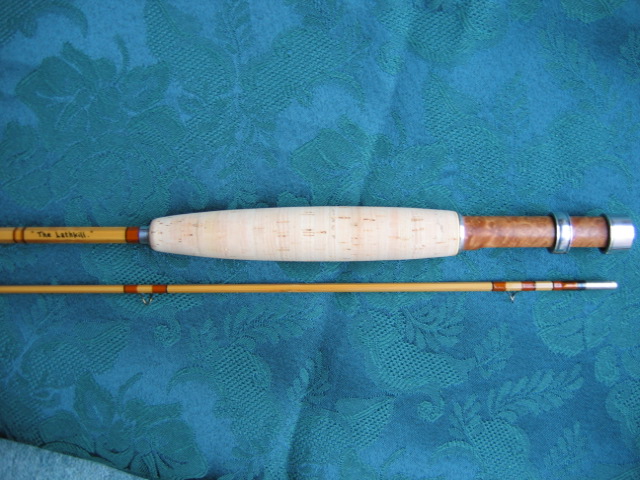
Try before you buy
How often are we exhorted by the angling press to adopt this approach and yet so few do. The majority of people buying a new fly rod do so on the basis of the marketting hype or after the perfunctory "waggle" in a shop.
All my rods are tested first by lawn casting in the garden, which fortunately is long enough to at least get the feel of a rod and try various lines. Accordingly I also offer this facility to all who are interested, just telephone to arrange a visit, I am always happy to talk cane. This facility gives interested anglers the opportunity not only to see my rods first hand but also to try different actions as I try and keep a range of rods for just this purpose.
Find a rod that really suits you.
Coarse Rods
I will happily design and make coarse fishing rods or replicate original tapers. Personally I am an Allcocks fan so if you want an Eclipse a Record Breaker a Nimrod or other similar classic replicating I can supply it. However as there are so many of these rods available on the second hand market I find I am more often called upon to undertake restoration work. The standard of finish on many of the old rods was often not that wonderful but after forty or more years it is not surprising that they are now a bit tired.
The optimum length argument also applies to the coarse rods particularly those that are held for sustained periods, for rods spending most of their time in a rest more liberties can be taken. For me anything over 11ft feels too heavy and even at this size a whole cane butt can improve the balance and feel. At 10ft 6inches a Roach or Chub sized rod all in split cane is reasonably light and great fun to use and I will make you one if you want. However, if you need a 15ft trotting rod use graphite, if you really want to put a "Gloria" through her paces and exercise your arm muscles I will happily refinish one but I won't make one from scratch.
The most common wish list cane rod is of course Richard Walkers Mark IV in Carp and Avon weights and there is a regular supply on ebay so it is not really worthwhile replicating them. Unless of course you really want one accurately made to Mr Walkers original taper and built to the standards of my fly rods in which case I can assist.
Almost all of my Coarse rods are hollow built which reduces weight by a significant amount and makes them much quicker in the hand.
Restoration - Coarse and Fly Rods
In Britain there are thousands of classic rods in the hands of collectors, traditional anglers and lurking in sheds waiting to appear on ebay. I am therefore often asked to restore rods and for a number of reasons. The nature of the rod and the reason for restoration dictate the approach adopted and great care is required if the value is to be maintained or enhanced. Restoration work must be done well unless it is only for your own use, for sale purposes collectors require originality or extremely good restoration.
It is therefore impossible to quote standard prices for this work and each rod is assessed on its merits and the scope of work agreed in advance. To some degree restoring rods has some parallels with other restorations such as bikes and cars in that similar restoration tasks will be a similar cost whether the value of the original is high or low so there is less economic benefit in restoring a cheap object. As a consequence many of the rods presented for serious work are quite valuable pieces requiring considerable care to avoid expensive mistakes.
It is necessary for anglers requiring restoration work to send or bring their rod to the workshop where I will happily examine it in detail and recommend a course of action. This examination is offered free of charge with no committment on either side.
I am happy to discuss requirements over the phone and can sometimes estimate the likely cost but this cannot be finally confirmed until after a thorough inspection. I am afraid I learnt this lesson the hard way. Having agreed just to replace the rings on a three piece coarse rod I went ahead and completed the work without properly inspecting the rest of the rod. Proud of my work on completion I decided to assemble the rod and see how it felt. It felt fine but when it was taken down both sets of ferrules remained tightly attached male to female - but not to the cane! Needless to say I had to strip off and re-fit all ferrule sections. Since then I work on the basis that neither rodmaker or customer really like surprises and try very hard to ensure the customer gets exactly what is wanted. I always provide a detailed report.

In the picture above the lower rod section is the original but fully restored, the upper section is a new matching tip.

As the above photograph shows this CC de France is proving to be a very capable fly rod in the hands of its owner. The brace of beautifully coloured scottish trout were taken from the Isla by Steven Keyse. Both fell to a March Brown.
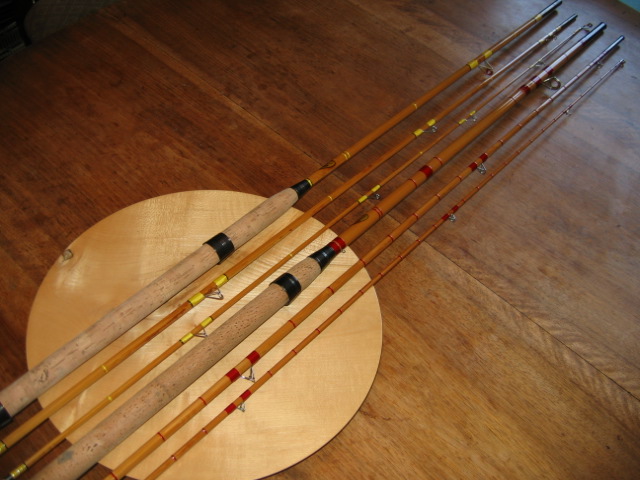
Two fine examples of fully restored rods pictured above, The Wizard and the Lucky Strike both famous Allcocks rods.
Another Lucky Strike pictured below and whipped in blue, as were several of the early rods. Blue is rarely seen on cane rods but as this striking example (no pun intended) shows, it can be very attractive.
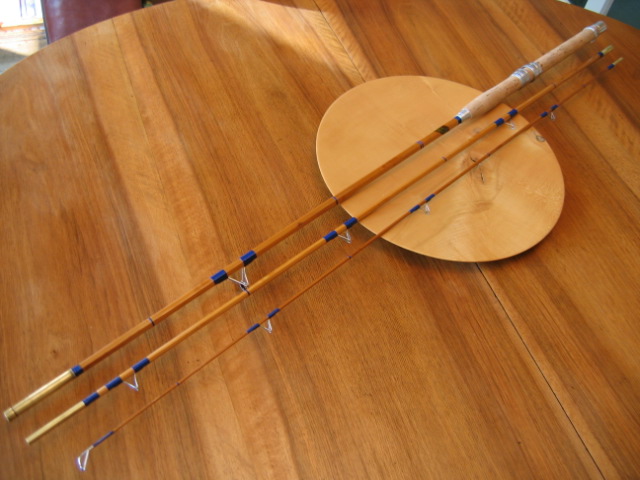

An early Avocet restored and put through its paces. The prize for first coarse fish on the website goes to Andy Pattison. More please!

Bits and pieces
I get many queries from people looking to restore or repair their own rods and I am happy to be able to assist where I can.
Due to the difficulty in obtaining good agate lined rings, particularly stand off butt rings and Hopton tip rings I have started making my own with nickel silver frames and genuine agate liners. I can therefore replace any missing rings with the correct style and size specifically made for the rod.
I have made these rings for other restorers but due to pressure of work these are not currently available.
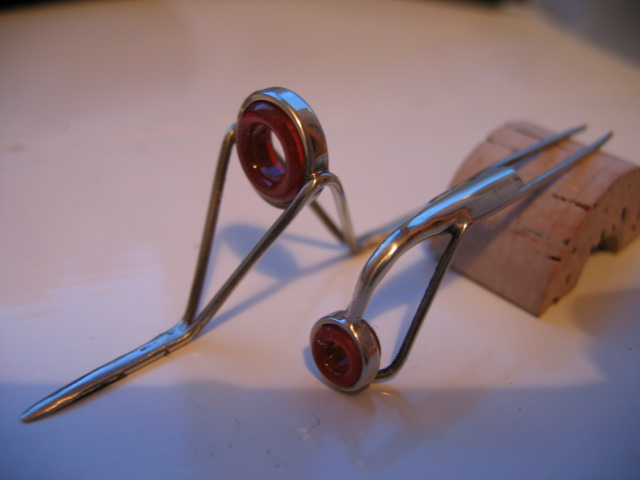
Two newly made nickel silver framed agate lined guides. In this case specifically made for the restoration of an Allcocks Record Breaker.
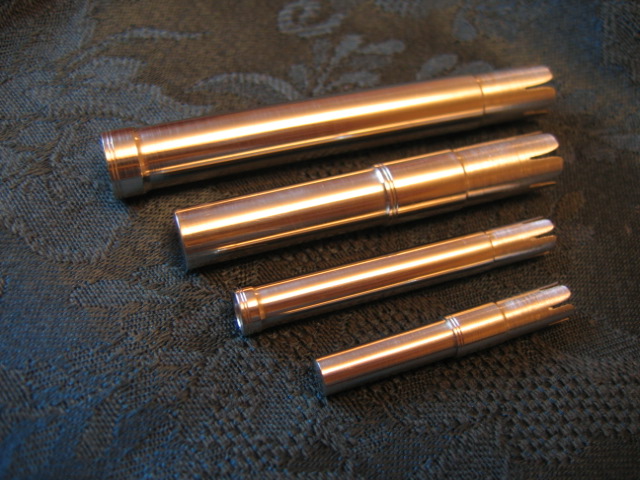
The above ferrules were were turned from solid nickel silver bar stock . Designed specifically for a custom built float rod.

Restoration of another CC de France called for replacement of a badly damaged sliding ring.
On the left the original, on the right a good example from another rod and in the centre the replacement part turned from aluminium and and stamped in an equally erratic style as the original!
|










